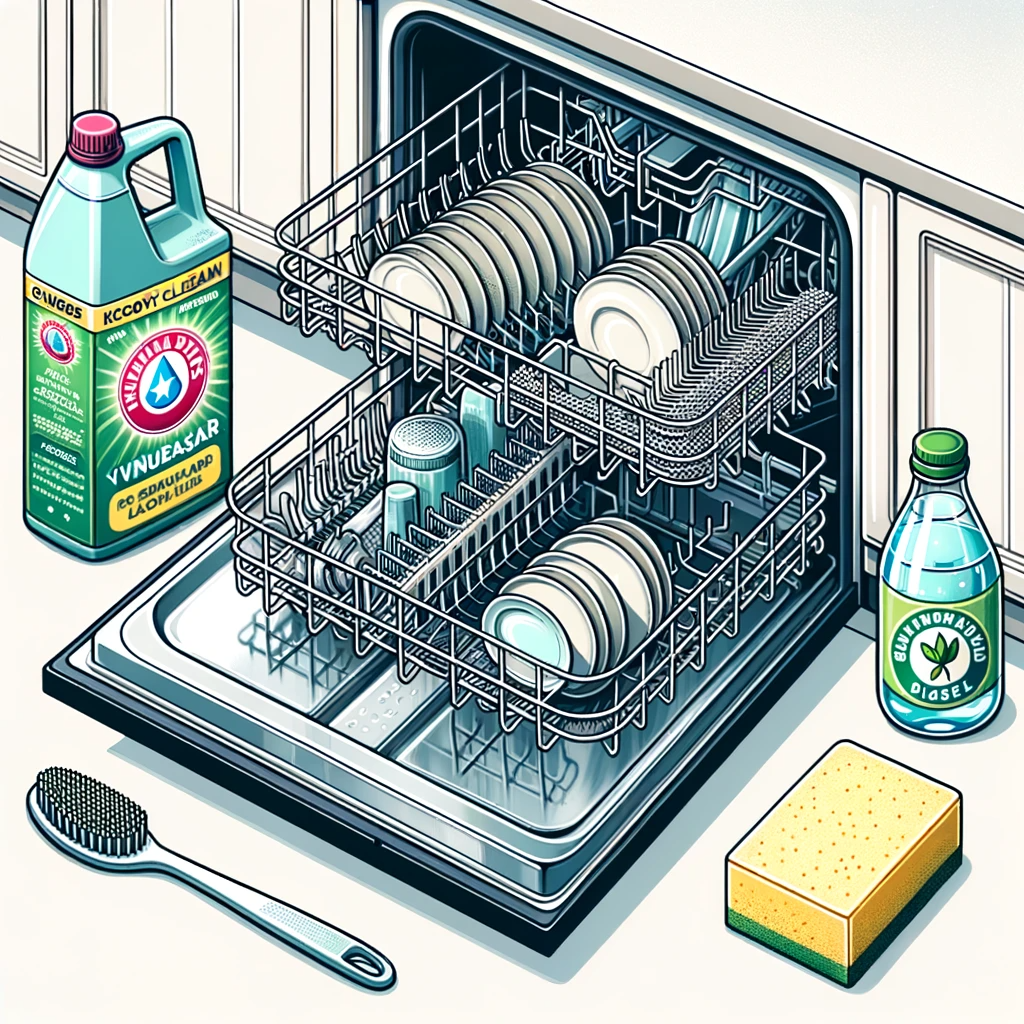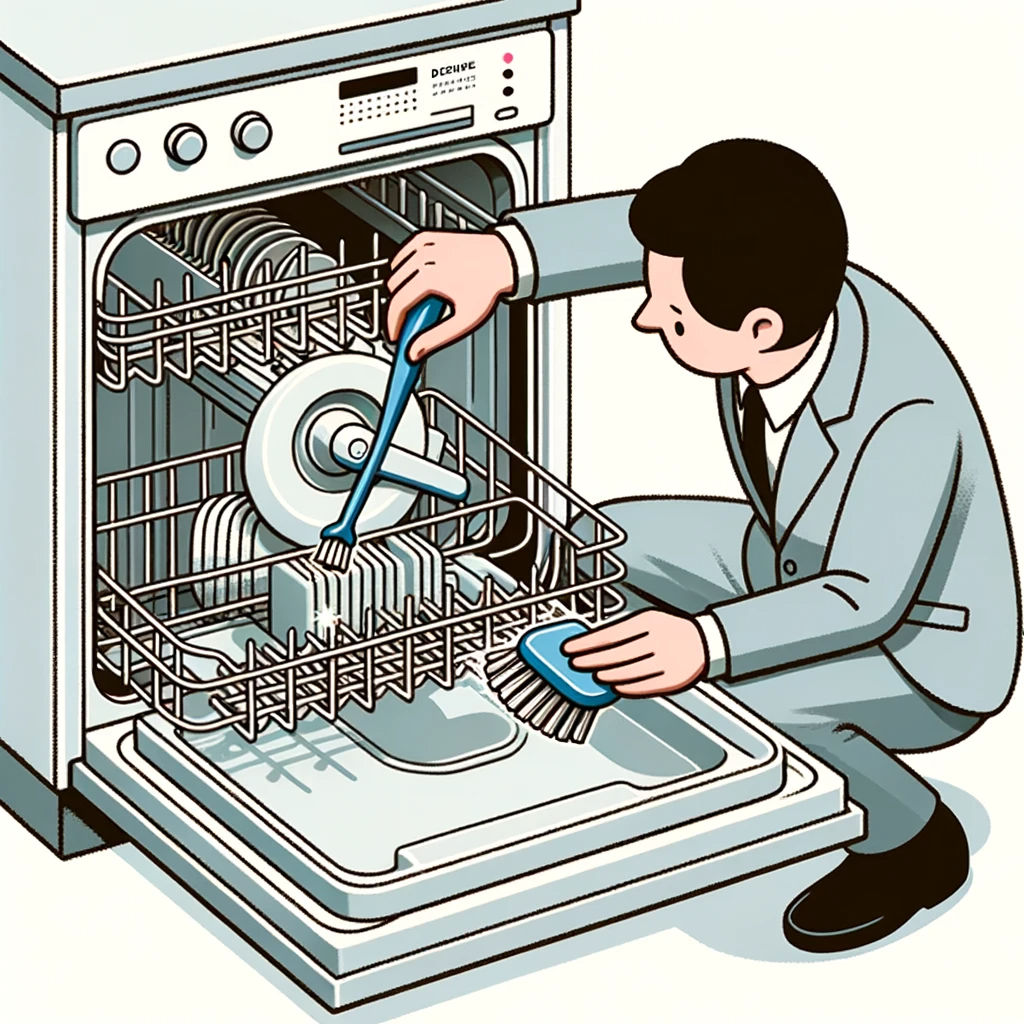Dishwasher Cleaning in 8 Simple Steps!
It might sound odd to clean a dishwasher, right? After all, isn’t a dishwasher perpetually clean since its primary function is to clean?
We often overlook the cleanliness of appliances like washing machines and dishwashers because they are inherently designed to clean other items.
However, over time, every dishwasher accumulates food particles, soap residue, and occasionally, pet hair, leading to an unsightly build-up of gunk.
Therefore, every dishwasher, once in a while, necessitates a thorough cleaning. Consequently, we have decided to guide you through cleaning your dishwasher in just 8 simple steps.

Cleaning Products and Supplies For Cleaning Dishwasher
For an eco-friendly dishwasher cleaning, here’s a list of ingredients and supplies you’ll need:
- Vinegar (white)
- Baking Soda
- Sponge
- A tool such as a screwdriver (check the screws before you start)
- A couple of toothpicks
- Soap or dishwashing detergent
- Old towels and microfiber cloths
- Old toothbrush
Cleaning a Dishwasher in 8 Steps
- Remove and Clean the Utensil Rack and Shelves Extract any food residues or detergent build-ups from the spinning arm holes using a toothpick. Ensure the spinning arm permits water to flow freely through it and wipe it with a sponge dipped in warm soapy water.
- Interior Cleaning: Wipe the walls, door, and dishwasher grate using a cloth soaked in warm soapy water. If the grid is too fine, utilize an old toothbrush to clean debris and remove food residues and soap build-ups. Also, clean the detergent dispenser with a sponge.
- Filter Removal and Cleaning: In some instances, a screwdriver may be necessary. Some dishwasher filters are secured with clips and are quite easy to remove. Take out the filter and scrub it with a toothbrush, warm soapy water, and baking soda under the sink, then rinse thoroughly.
- Door Seal Cleaning: Wipe the door seal with a cloth soaked in vinegar. Use a toothbrush or a Q-tip to access smaller areas. Applying vinegar can eliminate mold odors and inhibit mold growth.
- Ensure Rack Cleanliness: Remove any food particles from the utensil rack under the sink using dish soap and a toothbrush. Thoroughly rinse the dish racks under the sink.
- Reassemble All Components: Reinsert the filter, grate, top and bottom racks, and utensil rack into the dishwasher.
- Exterior Cleaning: Clean the dishwasher buttons with a cloth soaked in soapy water, then wipe them with a clean, damp cloth. Spray the dishwasher’s surface with a 1:1 solution of white distilled vinegar and water. Buff the sides and door with a dry microfiber cloth. Polish the stainless-steel exterior of your dishwasher with a dry towel.
- Run an Empty Cycle: If you need to remove hard water deposits, run an empty cycle with vinegar. Pour 2 cups of vinegar into the bottom of the dishwasher and set it to the energy-saving cycle.

Voila! Your dishwasher is now spotless! Depending on your usage frequency, repeat this procedure every 2-3 months. Remember, if you need a cleaning service that utilizes environmentally friendly products and supplies, do not hesitate to contact us!
How often should I clean my dishwasher?
It’s recommended to clean your dishwasher every 2-3 months, depending on how frequently you use it.
Can I use apple cider vinegar instead of white vinegar for cleaning?
Yes, you can use apple cider vinegar as a substitute for white vinegar. However, white vinegar is generally preferred due to its neutral color and stronger acidic properties.
What can I do if I notice a persistent unpleasant odor even after cleaning?
Persistent odors might indicate a deeper issue, such as a clogged drain hose. Consider consulting with a professional if cleaning does not resolve the issue.
Is it safe to use commercial cleaning agents for my dishwasher?
Yes, commercial cleaning agents designed for dishwashers can be used. Ensure to follow the instructions on the label and choose products that are safe for your dishwasher model.
Can I use the dishwasher without the filter?
It’s not recommended to use the dishwasher without the filter as it prevents large debris from clogging the drain. Always ensure the filter is clean and properly placed.







